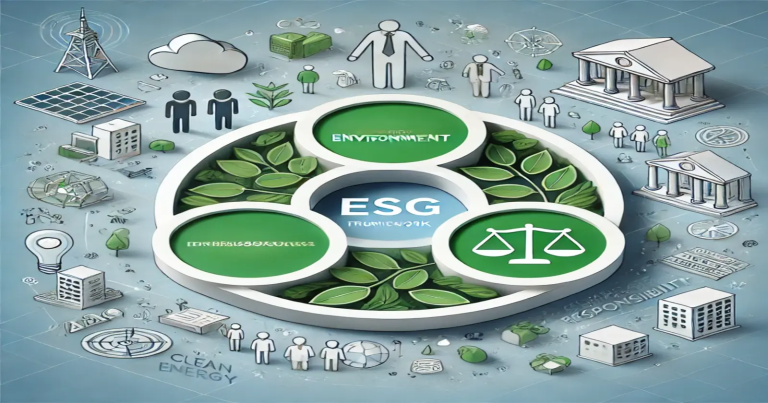Today, people want businesses to do more than earn money. They want them to act fairly, protect the planet, and care for others. This is where the ESG framework becomes important. The ESG framework helps companies measure and manage how they perform in three key areas—environmental, social, and governance. It gives a clear structure to track actions, set goals, and report results. This makes companies more open, ethical, and future-ready.
The ESG framework tells businesses what to look at, what to improve, and how to grow the right way. It helps leaders think beyond profits. It also supports long-term success. Companies use the ESG framework to find risks, reduce waste, help workers, and follow good rules. Investors also use it to choose where to invest their money. Customers and workers feel more loyal to companies that follow ESG principles.
What is the ESG Framework?
The ESG framework is a simple model that helps companies look at non-financial risks and measure their actions in three areas—Environmental, Social, and Governance.
E stands for Environmental—how a business uses natural resources and how it affects the planet.
S stands for Social – how a business treats people, including workers, customers, and communities.
G stands for Governance – how a business is managed and how it follows rules.
The ESG framework guides businesses to be responsible in these areas. It helps them make decisions that are good for the planet, for people, and for long-term growth.
This framework:
- Sets goals under each ESG pillar
- Tracks performance using ESG indicators
- Encourages companies to report their progress
- Helps avoid risks that come from ignoring environmental or social issues
- Builds trust with stakeholders and investors
Importance of ESG Framework
The ESG framework makes sure that businesses do not grow in a way that harms the environment or people. It helps companies act smartly and ethically. It also makes reporting clear and fair.
Environmental Pillar of the ESG Framework
The environmental pillar of the ESG framework helps companies reduce their harmful impact on the planet. It focuses on how businesses use energy, manage waste, and handle natural resources.
Key Environmental Areas in the ESG Framework
Companies must measure and improve their actions in areas like
- Carbon emissions
- Energy consumption
- Pollution control
- Water use and conservation
- Waste recycling
- Use of renewable resources
Why It Matters for Planet?
Climate change is real. Companies that pollute or waste resources may face strict laws, fines, or bad press. The ESG framework helps companies set goals to reduce carbon footprints and meet global climate targets.
How Companies Apply This?
Businesses track emissions, reduce plastic, install solar panels, and use energy-saving tools. They use reports to show what they are doing. These steps are not just for large firms. Even small companies can make changes using the ESG structure.
Social Pillar of the ESG Framework
The social pillar focuses on how companies treat people inside and outside the business. The ESG framework tells firms to care for workers, respect human rights, and give back to the community.
Main Social Factors in the ESG Framework
- Employee safety and fair wages
- Diversity and inclusion
- Customer data privacy
- Labor rights and human rights
- Community support and development
- Fair treatment in the supply chain
Why It Matters for People?
People want to work for companies that care. They also want to buy from brands that support justice and fairness. The social part of the ESG framework helps companies build trust and strong relationships with society.
How Businesses Use It?
Companies build safe workplaces, support equal pay, and offer skill training. They follow strict rules in hiring and working with suppliers. They also support social causes and include community goals in their strategy.
Governance Pillar of the ESG Framework
The governance pillar makes sure the business follows laws, respects stakeholders, and acts with fairness. It gives clear rules on how the company should be run.
Key Governance Issues in the ESG Framework
- Board independence and diversity
- Executive pay fairness
- Anti-bribery and ethical policies
- Shareholder rights
- Audit controls
- Transparency in decisions
Why Governance Builds Trust?
Bad governance can lead to fraud and collapse. Good governance helps avoid scandals. It builds confidence among investors, workers, and customers. Strong governance also keeps the other two ESG pillars working smoothly.
What Companies Should Do?
Companies should have diverse boards, open reporting, and strong audit systems. They must follow ethical rules and make leaders answerable. The ESG framework helps create a strong, clean system of management.
ESG Framework Pillars and Key Indicators
The ESG framework stands on three core pillars: Environmental, Social, and Governance. Each pillar includes specific indicators that help assess a company’s non-financial performance. These indicators offer measurable data to evaluate how responsibly a company operates.
| ESG Pillar | Key Focus Areas | Examples of Indicators |
| Environmental | Climate, waste, resource use | CO₂ emissions, energy usage, recycling rates |
| Social | People, rights, community | Worker turnover, safety incidents, D&I ratio |
| Governance | Leadership, fairness, compliance | Board structure, audit results, ethics code |
How Companies Use the ESG Framework in Real Life?
The ESG framework helps companies create policies, set goals, and report on progress. It also helps them avoid future risks and stay ahead of new laws.
Steps to Follow the ESG Framework
- Assess the current situation – Understand your impact on the environment, society, and governance.
- Set goals and KPIs – Make clear, measurable goals under each pillar.
- Create action plans – Assign roles, deadlines, and budgets to improve ESG performance.
- Track and report – Use tools to measure your progress and share reports with the public.
- Review and improve – Update your actions every year based on feedback and new challenges.
Real Company Examples
- Tata Group uses renewable energy, supports communities, and follows clean governance.
- Infosys shares ESG progress in their reports and supports digital learning.
- Wipro focuses on water saving, employee well-being, and board diversity.
These companies show that the ESG framework works well when taken seriously.
Benefits of Using the ESG Framework
The ESG framework helps companies manage risks, improve sustainability, and build trust. It goes beyond financial performance to assess how companies impact the environment, treat people, and manage themselves. Let’s explore the key advantages in detail:
- Better reputation – People respect firms that care for more than profit
- Loyal customers – Customers support brands with good values
- Stronger teams – Workers stay with ethical and fair companies
- Lower risks – Firms avoid legal or brand damage
- More investment – Investors look for ESG-focused companies
Companies that follow the ESG framework grow in a strong, steady way.
Relevance to ACCA Syllabus
The ESG framework is integrated into the Strategic Business Leader (SBL) and Strategic Business Reporting (SBR) papers. ACCA expects students to understand how the ESG framework supports sustainable reporting, corporate governance, and stakeholder communication. The framework helps assess ethical performance and long-term value creation.
ESG Framework ACCA Questions
Q1: What does the ESG framework primarily help companies achieve?
A) Higher short-term profits
B) Stronger product branding
C) Better financial forecasting
D) Responsible and sustainable business practices
Answer: D) Responsible and sustainable business practices
Q2: In ACCA reporting, which of the following is a ‘Governance’ component in the ESG framework?
A) Carbon footprint
B) Board composition and transparency
C) Community outreach programs
D) Employee training schemes
Answer: B) Board composition and transparency
Q3: What is the purpose of using ESG reporting frameworks like GRI or SASB in financial reports?
A) To avoid tax penalties
B) To improve profit margins
C) To disclose non-financial risks and actions
D) To reduce audit scope
Answer: C) To disclose non-financial risks and actions
Q4: Which ESG pillar is linked to human rights and labor standards?
A) Environmental
B) Financial
C) Social
D) Governance
Answer: C) Social
Relevance to US CMA Syllabus
In the US CMA syllabus, the ESG framework fits within strategic planning, performance management, and risk assessment. Management accountants must evaluate how ESG factors affect business value, operational efficiency, and sustainable decision-making.
ESG Framework US CMA Questions
Q1: The ESG framework helps CMAs improve strategic planning by:
A) Cutting fixed costs
B) Ignoring environmental risks
C) Identifying long-term operational risks and opportunities
D) Boosting short-term stock prices
Answer: C) Identifying long-term operational risks and opportunities
Q2: Which pillar of the ESG framework would cover employee well-being and safety?
A) Governance
B) Strategic
C) Social
D) Financial
Answer: C) Social
Q3: In performance reporting, ESG metrics are often included to:
A) Comply with advertising rules
B) Measure cost of goods sold
C) Support sustainability targets and stakeholder trust
D) Track interest rates
Answer: C) Support sustainability targets and stakeholder trust
Q4: Which ESG area would a company address by investing in energy-efficient systems?
A) Social
B) Financial
C) Governance
D) Environmental
Answer: D) Environmental
Relevance to CFA Syllabus
CFA candidates study ESG frameworks as part of Ethics, Portfolio Management, and Investment Analysis. The ESG framework helps evaluate company risks, long-term value, and ethical investing. ESG factors are now central in evaluating sustainability-related disclosures and making investment choices.
ESG Framework CFA Questions
Q1: ESG integration in portfolio management helps investors to:
A) Avoid all financial risks
B) Improve liquidity ratios
C) Evaluate sustainability and ethical business risks
D) Increase bond yields
Answer: C) Evaluate sustainability and ethical business risks
Q2: Which part of the ESG framework involves anti-corruption policies and leadership transparency?
A) Environmental
B) Financial
C) Governance
D) Social
Answer: C) Governance
Q3: A company’s commitment to reducing water usage fits under which ESG category?
A) Economic
B) Governance
C) Social
D) Environmental
Answer: D) Environmental
Q4: Why should CFA analysts include ESG factors in valuation models?
A) They are legally required for all firms
B) ESG issues may impact financial performance and long-term valuation
C) They simplify the modeling process
D) ESG factors replace traditional financial ratios
Answer: B) ESG issues may impact financial performance and long-term valuation
Relevance to US CPA Syllabus
In the US CPA syllabus, the ESG framework is included in Audit (AUD), Business Environment and Concepts (BEC), and Regulation (REG). CPAs analyze ESG risks, support assurance on ESG reports, and guide companies on non-financial compliance.
ESG Framework US CPA Questions
Q1: ESG frameworks are most useful to CPAs when evaluating:
A) Cost allocation
B) Non-financial reporting and sustainability disclosures
C) Shareholder dividend history
D) Credit scoring
Answer: B) Non-financial reporting and sustainability disclosures
Q2: What role does the CPA play in ESG assurance?
A) Forecast market trends
B) Verify the fairness and completeness of ESG-related disclosures
C) Draft annual marketing reports
D) Value brand goodwill
Answer: B) Verify the fairness and completeness of ESG-related disclosures
Q3: Which ESG component would include anti-fraud policies and code of conduct?
A) Social
B) Governance
C) Market
D) Environmental
Answer: B) Governance
Q4: ESG disclosures are increasingly reviewed during audits to assess:
A) Sales promotions
B) Non-financial risks and reputational exposure
C) Payroll processing systems
D) Supplier discount rates
Answer: B) Non-financial risks and reputational exposure


